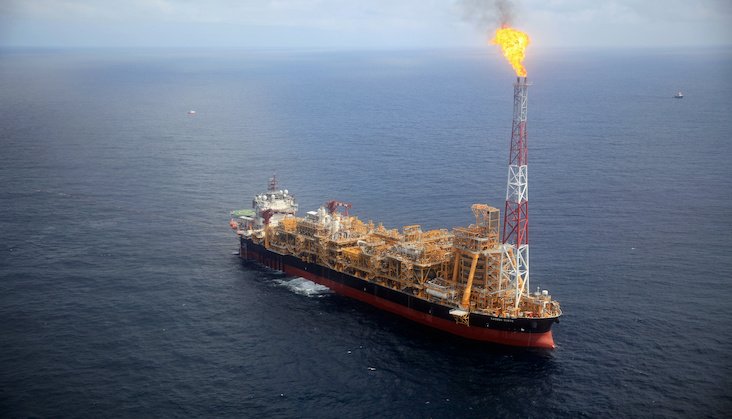
This originally appeared on TheAfricaReport.com
Oil-price volatility highlights the fragility of a development model based on a single resource. For oil-producing countries the imperative of adopting a more diverse investment strategy can no longer be ignored.
Crude oil prices started 2019 with downward pressure from increasing output and a global economic slowdown.
- Oil prices dropped in 2018 for the first year since 2015, underlined by a near 25% plummet in November 2018 alone.
- Supply boomed in 2018 with record oil production by some of the world’s largest producers, including Russia, Saudi Arabia, and the United States.
- At the same time, global demand slowed as importers endured a stronger US dollar and consequently more expensive oil.
As these factors play out in 2019, the Brent oil price may average below $70. The current Brent price of $71.86 as of 16 April is buoyed by OPEC’s production cuts, output declines in sanction-entangled Iran and Venezuela, and an intensifying conflict in Libya. Although many investment banks have raised their price forecasts in recent weeks, they equally concede volatility is likely to be the storyline in 2019.
An uncertain future for development
This new reality points to greater uncertainty for sub-Saharan Africa and a changing scenario for African development. Take Angola and Nigeria, for example, where the end of the great commodity boom in 2014 has been a drag on both respective economies. Prices plunged from $112 per barrel in mid-2014 to a brief low of $28 in 2016; this created a fiscal crisis and quickly made a plethora of infrastructure, industrial and other development-related projects no longer affordable going forward.
That was partly acceptable to leaders and their constituents as some projects were expensive, but, as the price drops threatened the more necessary government expenses, including public servant salaries and public services, public concern grew and is only further fomented by the withdrawal by foreign investors from these markets.
Angola focused on the short term
Angola may be the epitome of missed opportunity and struggle in this new oil-price environment. Infrastructure remains underdeveloped despite the boom years. With Angolan oil production around 1.6 million barrels per day (bpd) in 2018 compared to almost 1.9 million bpd in 2008, budget officials are adjusting to a new world.
- Angolan officials constructed a budget in 2017 that suggested a break-even oil price of $82 – the price necessary to cover the cost of production for oil in the country and associated public expenditures tied to its production.
- This number is roughly $65 in 2019… despite a current Brent price of $70-plus, the local offtake price (currently below $65 per barrel) and volatility in the market suggest the country may barely break even on its budget.
For a country that collects nearly 95% of its export revenue from oil, the lower price environment and reduced production spells trouble in the short term and greater changes to government planning in the long term. Officials recently announced an effort reduce the fiscal deficit from 7% to sub-4% and overall debt from 60% to, at least, 55% of GDP.
Angolan officials are already pursuing an aggressive sell-off, including the sale of interest by Sonangol in 50-plus companies not involved in the crude-oil business, as part of an operational restructuring of the national oil company and as a pathway to funding the most immediate shortfalls in the Angola budget. These efforts, nevertheless, do not suggest a long-term solution for the country.
Nigeria still spending
Nigeria’s 2019 budget assumes a break-even oil price of $60, compared to $120-$130 in 2017 (with the 2017 break-even price including numerous projects planned pre-2014 oil price crash). Increased Nigerian output will add to total revenue for the country and help soften the impact of price volatility.
- For example, Nigeria’s crude and condensates output, which in mid-2016 nosedived to a 30-year low around 1.1 million bpd (with the militancy outbreak in the Niger Delta), was around 2 million bpd in October and November of 2018.
- Full capacity in Nigeria is approximately 2.2 million bpd, suggesting upside here for the country.
That said, the Nigerian budget generally incurs overruns throughout the year and will likely consume the extra revenue and still create trouble in the short- and long-term for Nigerian fiscal health. Furthermore, fresh off an electoral mandate, President Muhammadu Buhari is unlikely to reduce spending, especially as it relates to civil servants and public services.
The strategy with budgeting and planning thus becomes one targeting spending reduction on big government projects (i.e., infrastructure), which is hard to achieve in a political environment where government spending is vital to the country’s development (and to winning elections).
South Sudan and Sudan as odd bedfellows
Although not major oil producers like Angola and Nigeria, South Sudan and Sudan provide insight into the troubles of oil-financed development. The civil war that separated these countries is now overshadowed by their inability to cooperate and the subsequent economic destruction that has ensued.
- South Sudan is targeting 200,000 barrels per day, which would be approximately a 33% bump from 2018 numbers.
This production nevertheless is dependent on access to Sudan’s export terminals. As prices have fallen (albeit coupled with disruptions in production), the tension over revenue sharing has escalated with both countries struggling to service prior debts as well as fund current government expenses.
South Sudanese officials now must plan for a Sudanese sovereign who lacks foreign currency to import oil
Sudan remains in the midst of a debt-restructuring and financial crisis that is now coupled with the dethroning of President Omar al-Bashir. Not knowing when the next democratic election will occur further exacerbates economic troubles. South Sudanese officials now must plan for a Sudanese sovereign who lacks foreign currency to import oil as well as increased challenges accessing export terminals in Sudan. Thus, South Sudanese officials assume the price per barrel obtainable will fall significantly below the Brent oil price due to limited access to offtakers in the region and transport complexities.
Are the gas players any different?
Mozambique in a debt hangover before the party started
The discovery of natural gas reserves in the Mozambican Rovuma basin around 2012 was the catalyst for newfound optimism in one of the world’s least developed countries. Those hopes for a gas revolution –underwritten by the two major liquefied natural gas (LNG) projects previously expected to come online in 2018 – have been massively tempered by the global markets and the previous internal management of the country.
First and foremost, some of Mozambique’s previous leadership mortgaged the country’s LNG future through secret borrowing that created a massive debt overhang for the country. The hidden “tuna” debt – which came to the public eye in 2016 – triggered a sovereign default for the country and will likely mould the economic and political outlook for the country over the next decade (if not longer).
Second, the global markets punished Mozambique for its missteps, with most banks and investors pulling out of the country. The Mozambican government now expects LNG production to come online in 2023, with gas exports approaching 18 billion cubic metres in 2024. The Rovuma basin, which contains more than 180 trillion cubic feet (tcf) of recoverable gas, will remain the centrepiece of this Mozambican growth story.
- Despite the presence (and expertise) of major producers, including Eni, Anadarko (now owned by Chevron) and ExxonMobil, many projects have endured long marketing and financing campaigns, with only one reaching financial close before the start of 2019 (Eni’s $4.7bn Coral South floating LNG project, with a planned production capacity of 3.4 million tonnes per annum).
The long timeline to production implies a tough financial runway for the country – with lenders already timid on the gas story prior to the full production in the country.
Tanzania struggling to excite foreign investors
Tanzania is East Africa’s first petroleum producer (along with small amounts of gas production since 2004). The greatest potential conspicuously lies with the country’s ability to develop LNG from the gas reserves first discovered in 2010. The state oil company, the Tanzania Petroleum Development Corporation (TPDC), wants to license several blocks in 2019 but interest remains tempered by the complexities of the current political, legislative, and economic environment.
Tanzanian President John Magufuli announced in March 2016 that the state-run Tanzania Electric Supply Company (Tanesco) would be the only power generator in the country going forward. This announcement was joined by the introduction of the bold Natural Gas Utilisation Master Plan (2016–2045), which focuses on industrial and power generation use in Tanzania, as well as regional pipeline exports, and was supposed to build off the National Natural Gas Infrastructure Project (NNGIP).
The NNGIP’s and Tanesco’s debt will discourage further development of gas reserves in Mozambique
Despite expansion of production related to the NNGIP, and a more than 532km pipeline from Mtwara in southwestern Tanzania to Dar es Salaam, gas development remains at risk of delayed payments from the offtaker Tanesco. The NNGIP is state-owned but funded by a loan from China’s Exim Bank. Its debt, coupled with Tanesco’s debt, estimated at $490m by the World Bank in 2016, serves to discourage further development of gas reserves in the country. As nationalist rhetoric escalates in the Tanzanian energy sector and the greater economy, foreign investors and lenders will only further pull back from the country, leaving Tanzanian officials struggling to write the next chapter on the gas boom.
The changing dynamics of sub-Saharan African development
Sub-Saharan African development remains hindered by lack of access to energy services, which is further underscored by an inability to develop major oil and gas projects in the region. Governments are unable to fund the majority of large infrastructure projects through current revenues and must pursue more appropriate long-term methods of funding. More specifically, the thinking must be one that targets commercially viable projects – in the energy sector and beyond – that can, on a standalone basis, attract long-term investors (including those opportunities requiring development financing institution capital).
This strategy, as many investors and market analysts acknowledge, is being driven by the public spending cuts, weakening African currencies, and depressed foreign direct investment in many sub-Saharan African countries. Resource nationalism, as should be noted, and the desire to extract the greatest revenue share for the government for oil and gas projects, will only further stall foreign investment (and consequently shrink governments’ overall oil and gas revenue, with fewer projects coming to fruition).
- Lending on future income streams clearly remains central to government financing. But modesty and constraint are required with financial projections at a governmental level. First step will be unbundling projects… for example, bundling a couple of strong oil infrastructure projects with four mediocre oil infrastructure projects in a high-oil-price environment can manifest strong returns to a government but fail two years later when oil prices only justify sustained investment in the two strong projects.
- Second step is structuring and financing projects that account for the volatility of prices and create downside risk protections.
- Third step is realising that some projects can be ignored because they simply do not make economic sense in the current price, interest, and/or political environment.
- Lastly, oil and gas, in today’s price environment and in the future, cannot be the sole driver and financier of development.
Between mismanagement, the resource curse (i.e., the over-allocation of spending to natural resource development), and the natural volatility in global markets, the one-resource driven development model must give way to a more diverse investment strategy (i.e., investment diversified across multiple sectors). If this change does not happen, we will be referencing 2019 as another missed opportunity to rewrite the future of struggling resource-rich (but financially poor) countries.
